Following in the footsteps of Saint Catherine of Siena, you'll be able to visit the most significant places of 14th century Siena. The Cathedral and the Baptistery, the Oratory of "Saint Catherine of the Night" at Santa Maria della Scala, the Basilica of Saint Dominic and the Shrine of the House of Saint Catherine. The Sienese cathedral is undoubtedly the fulcrum of any itinerary aiming to capture the meaning behind the extraordinary persona of Saint Catherine and the role she played in the history of the Church and of Europe. There are numerous depictions of Saint Catherine inside the Cathedral, such as the marble sculpture by Antonio Raggi in the Chapel of the Madonna del voto, the large statue of Giovanni di Stefano in the pendentives of the dome, the canvas by Pietro Dandini with the mystical Marriage of Saint Catherine and the apsidal fresco by Ventura Salimbeni, where the saint is portrayed together with the more important saints and blessed from Siena.
The fresco by Bernardino di Betto (known as Pinturicchio) in the Piccolomini Library, commemorating the canonization of Saint Catherine in 1461 by Enea Silvio Piccolomini (Pope Pius II) is of great importance. In front of the Cathedral, the ancient Hospital of Santa Maria d... more
The fresco by Bernardino di Betto (known as Pinturicchio) in the Piccolomini Library, commemorating the canonization of Saint Catherine in 1461 by Enea Silvio Piccolomini (Pope Pius II) is of great importance. In front of the Cathedral, the ancient Hospital of Santa Maria della Scala houses the Oratory of Saint Catherine of the Night: an evocative place, where Catherine prayed and did penance together with the brothers of the ancient company of Saint Michel the Archangel. By means of a staircase that connects Piazza Duomo to Piazza San Giovanni, we can reach the Baptistery, where Catherine, like all the people in Siena at the time, received her baptism. Along the staircase, a small cross on one of the steps marks the spot where the saint fell during a temptation from the devil. Following via del Costone, which is the place where the child Catherine had her first vision of Jesus in pontifical clothes, we come to the Basilica of Saint Dominic with its imposing Gothic architecture. It was here that the saint lived the highlights of her exceptional mystical experience, and it is here that the most important relic, the sacred head, is venerated. Our journey ends with a visit to the House of Catherine, which over the centuries has become a true shrine, where we can admire splendid sixteenth and seventeenth century frescoes that retrace the salient episodes of the life of the saint of Siena.
lessCatherine Benincasa, known as Catherine of Siena, was born in 1347, daughter of the dyer Jacopo Benincasa and his wife Lapa di Puccio de' Piacenti. She was the twenty-fourth out of 25 brothers and sisters, and she was a twin. Catherine's family lived in the "Goose" neighbourhood, "Contrada dell'Oca". Her mystical charisma can be seen from a young age, when at the age of six she had her first vision of Christ the Pontiff accompanied by the apostles Peter and Paul. From that moment on she decides to dedicate her life to God, but with not a few difficulties, since her parents hinder her vocation and try to get her to marry. In 1363, after years of prayers and penance, she received the habit of the Dominican Third Order (a form of lay consecration). At the age of twenty she received the ring of her mystical wedding with Jesus, and she dictated her first letters (she did not yet know how to write and had just learned to read), and she began her charitable activities with the poor, the sick, and the imprisoned. She was often repaid with ingratitude and slander. In 1370, the exchange of hearts between Catherine and Jesus took place and the following year her first disciples gathered around her.
In 1939 (June 18th) Catherine of Siena and St. Francis of Assisi were proclaimed primary patrons of Italy by Pius XII. In 1970 (October 4th) Paul VI conferred the title of Doctor of the Universal Church upon Catherine. On October 1st 1999, Pope John Paul II proclaimed Catherine co-patroness of Europe.
By train: The train takes about an hour and a half from Florence to Siena and runs frequently every day. If you arrive from Pisa you may need to change trains in Empoli. The train from Rome is a little more uncomfortable and not so frequent: you have to change trains in Chiusi. The Siena railway station is located about 1.5 km from the historic city center. The journey is practically all uphill.
By plane: If you arrive at the Florence airport, you can take the shuttle bus (€ 3.10 tickets are on sale from the driver). There is a shuttle bus every hour from Florence Airport, or take a taxi (around € 15) to Florence Central Station (Firenze Santa Maria Novella, Firenze SMN). The shuttle bus (Volainbus) leaves the airport every 30min from 6:00 AM to 8:30 PM, and every hour from 8:30 PM to 11:30 PM, Monday to Sunday. Journey time is 26-28 minutes. The cost of the ticket is € 4.00, tickets are on sale on board.
By car: Getting to Siena by car takes about two hours from Rome and 45 minutes from Florence. Remember that car traffic is strictly limited to circulation outside of the city walls, unless you have a special permit issued by your hotel which allows you to enter the city walls in order to park. The parking lot near the city walls is often full, between locals and tourists seeking to park.
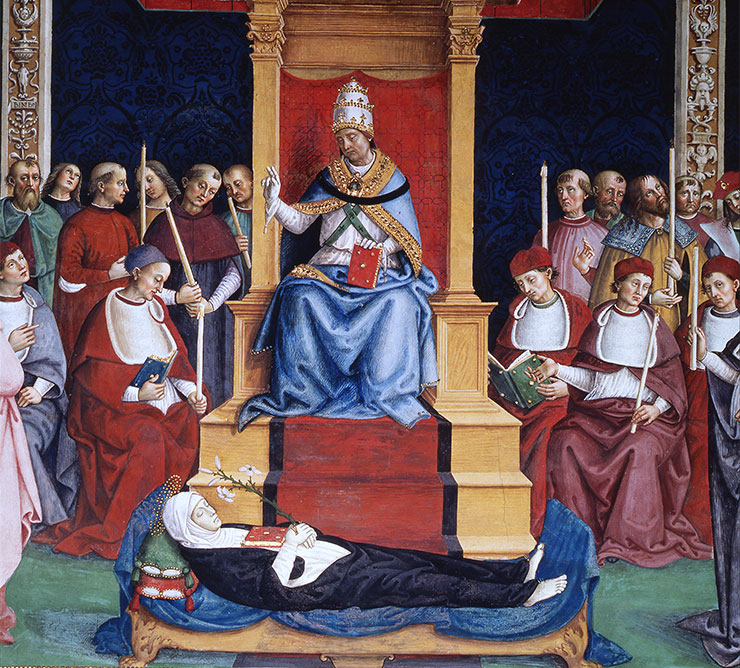
In the Piccolomini Library, to the left side of the Cathedral, you can see the famous fresoes by Pinturicchio depicting the biography of the humanist Enea Silvio Piccolomini, Pope Pius II.
The ninth of the ten scenes painted by Pinturicchio depicts the Canonization of Saint Catherine. Pope Pius II canonized Caterina Benincasa in Saint Peter's Basilica in the year 1461, at the presence of cardinals and bishops, having her name added to the catalog of the holy virgins.
less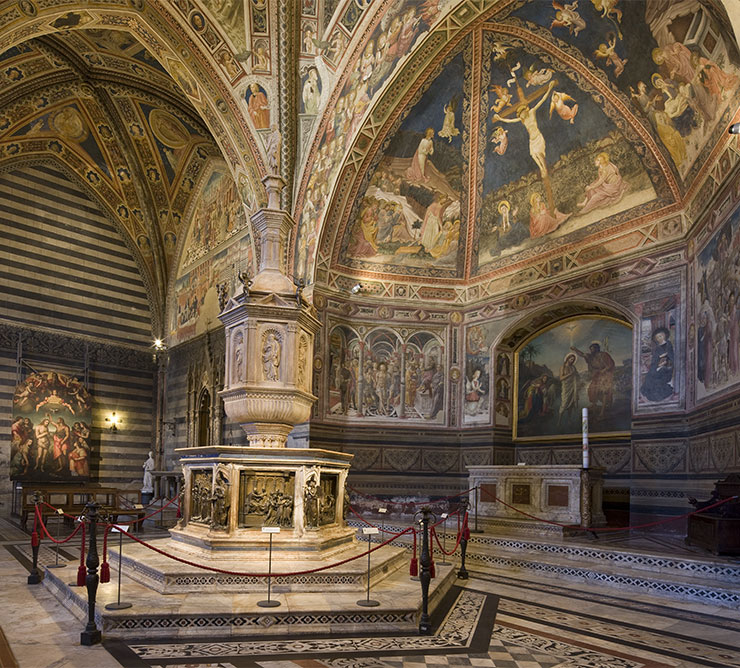
Catherine received the sacrament of baptism here, just like all the people from Siena at the time. In the Baptistery, you can find some of the finest examples of fifteenth century Sienese painting.
From the early fourteenth century, the art in Siena begins to depict the Articles of the Creed, taking inspiration both from the Nicene Creed which was recited during Mass, and from the Apostles' Creed the recital of which was required for admission to baptism. In the mid-fifteenth century, Lorenzo di Pietro, known as "il Vecchietta", depicts the dictates of the Apostolic Creed in the decoration of the vaults of the Sienese Baptistery, demonstrating great theological competence. The fulcrum of the temple is the large fifteenth-century marble and bronze baptismal font, the making of which saw the participation of some of the most important artists of the time, such as Lorenzo Ghiberti and the great Florentine master Donatello, who made the panel with Herod's Banquet. Along the scenic staircase that leads from the Duomo to the Baptistery, a small cross has been carved into a step to memorialize the place where, according to tradition, Catherine was tempted by the devil.
less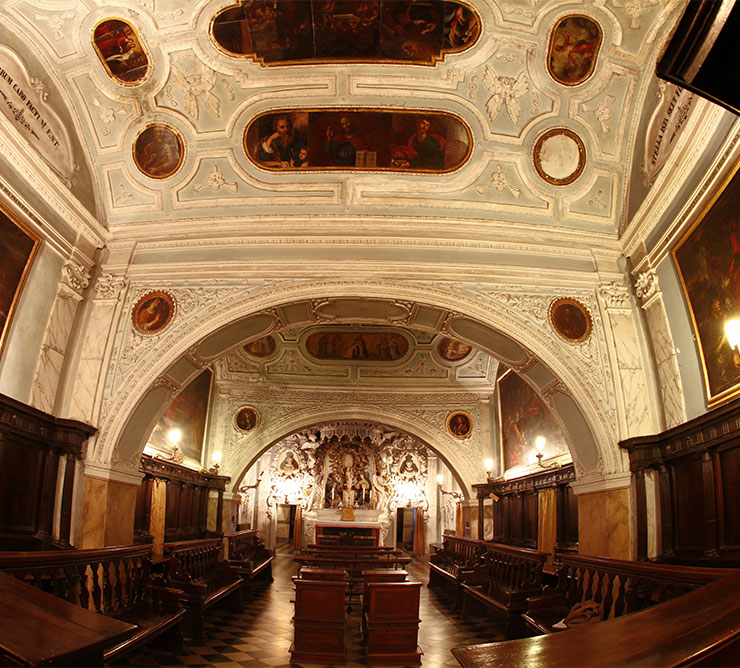
This evocative environment is located in the heart of the millenary hospital of Santa Maria della Scala, one of the oldest hospitals in Europe, where Catherine went daily to bring assistance and comfort to the needy.
Along the walls of the oratory, you can see the wooden stalls where the brothers sat during the meetings. The vaulted ceiling is characterized by a late seventeenth century stucco decoration, while on the walls there are canvases mostly depicting episodes from the life of the saint. Catherine used to pray in this room after alleviating the physical and spiritual suffering of the sick, allowing herself a few moments of rest inside the cell that opens on the left side of the oratory. There is a seventeenth-century polychrome terracotta statue portraying Saint Catherine as she sleeps, to memorialize her sleeping on the bare stone inside the cell.
less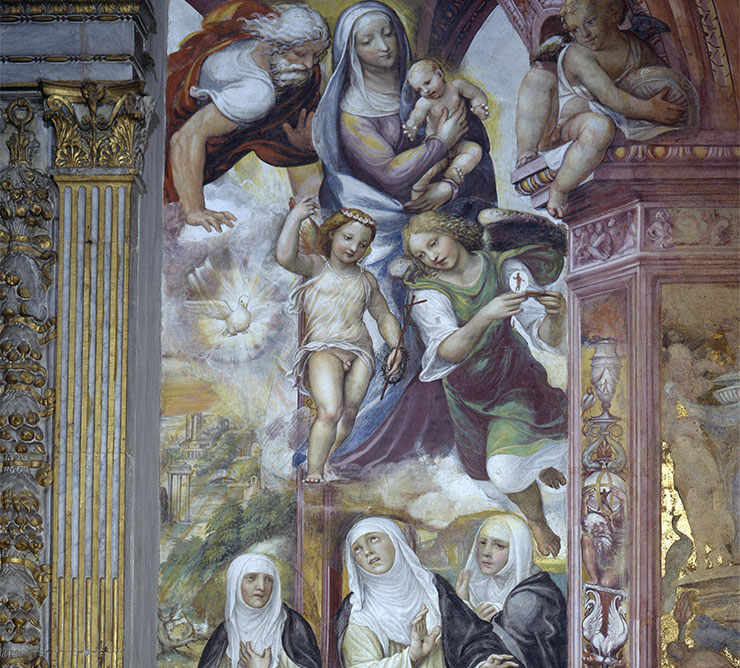
After the Catherine's canonization as a saint on June 29th 1461, under Pope Pius II, this chapel was built in order to house the precious relic of her head.
Raimondo da Capua, Catherine's confessor, had managed to bring the saint's head back to Siena after her death, after Pope Urban VI had granted permission to detach it from her body. The 1466 marble sculpture by Giovanni di Stefano preserves the relic, which is protected by a gilded grate and inserted in a modern enameled silver urn in the shape of a Gothic temple. In 1526 Sodoma created two of his most famous masterpieces on the sides of the altar, the Mystical Fainting and the Ecstasy of the Saint, which testify to the intensity of Saint Catherine's prayer.
less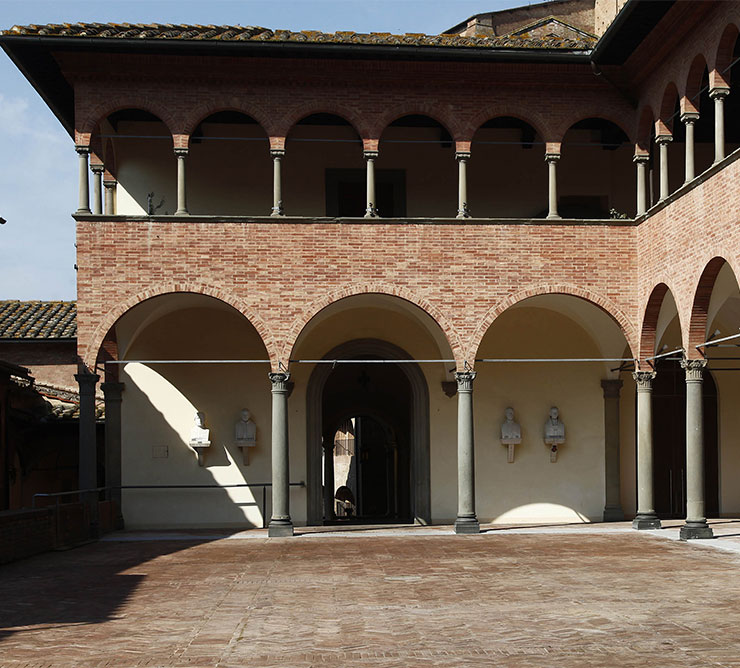
Catherine lived in the house where she was born, located in the Fontebranda area, for most of her life.
The house, which is accessed through a large portico known as the Municipalities, is divided into various rooms: the Church of the Crucifix, the Chapel of the Confessions, the Oratory of the Kitchen and the Oratory of the Chamber, located on the lower floor. Over the centuries, thanks to the activity of the brothers, the house has undergone numerous transformations, enriching itself with extraordinary works of art that retrace and enhance the life and work of the saint. Among the most representative works, the wooden crucifix from which Saint Catherine received the stigmata. The miraculous event took place in Pisa, where the Saint had gone in 1375. In the Legenda Major, Raimondo da Capua, confessor of Caterina, narrates that while she was absorbed in prayer in the church of Saint Christine, Catherine saw her descend from the crucifix in front of which she was kneeling with five blood-red rays directed at her hands, feet and heart. The stigmata, which mark the culmination of her spiritual journey and represent Catherine's identification with Jesus Christ, remained visible only to herself, until, at the moment of her death, they were miraculously revealed to everyone. The wooden cross of the school of Pisa, datable to the end of the thirteenth century, arrived in Siena in 1565 thanks to the Confraternity dedicated to the Saint. In the seventeenth century, inside the house of Catherine, the Church of the Crucifix was built and the crucifix, on May 21, 1623, after a solemn procession through the major places of worship in the city, was placed in the center of the main altar, where we can still admire it today.
less